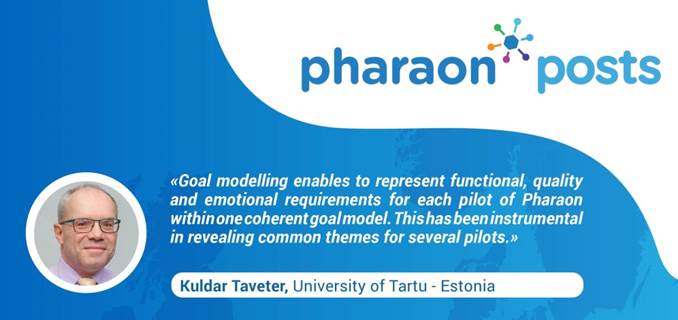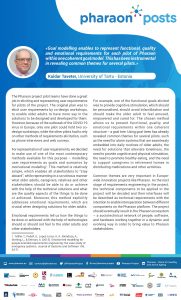
25 Jun Pharaon posts! Kuldar Taveter, Leader pilot and user requirements
 The Pharaon project pilot teams have done a great job in eliciting and representing user requirements for pilots of the project. The original plan was to elicit user requirements by co-design workshops, to enable older adults to have more say in the solutions to be designed and developed for them. However, because of the outbreak of the COVID-19 virus in Europe, only one pilot could hold two co-design workshops, while the other pilots had to rely on other methods of requirements elicitation, such as phone interviews and web surveys.
The Pharaon project pilot teams have done a great job in eliciting and representing user requirements for pilots of the project. The original plan was to elicit user requirements by co-design workshops, to enable older adults to have more say in the solutions to be designed and developed for them. However, because of the outbreak of the COVID-19 virus in Europe, only one pilot could hold two co-design workshops, while the other pilots had to rely on other methods of requirements elicitation, such as phone interviews and web surveys.
For representation of user requirements, we decided to make use of one of the most contemporary methods available for this purpose – modelling user requirements as goals and scenarios by motivational modelling[1]. This method is relatively simple, which enables all stakeholders to “stay aboard”, while representing in a scrutinous manner what older adults, caregivers, relatives and other stakeholders should be able to do or achieve with the help of the technical solutions and what are the quality aspects of the things to be done or achieved. Moreover, this method explicitly addresses emotional requirements, which are crucial when designing solutions for older adults.
Emotional requirements tell us how the things to be done or achieved with the help of technologies should or should not feel to the older adults and other stakeholders. For example, one of the functional goals elicited was to provide cognitive stimulation, which should be personalised, should avoid infantilization and should make the older adult to feel amused, empowered and cared for. The chosen method allows us to present functional, quality, and emotional requirements within one coherent structure – a goal tree. Using goal trees has already revealed common themes for several pilots, such as the need for alarm systems that are seamlessly embedded into daily routines of older adults, the need for solutions that alleviate loneliness, the need to provide cognitive and physical stimulation, the need to promote healthy eating, and the need to support caregivers in retirement homes in distributing medications and other activities.
Common themes are very important in Europe-wide innovation projects like Pharaon. As the next stage of requirements engineering in the project, the technical components to be applied in the project will be decided and their interfaces will be described as technical requirements with the intention to enable interoperation between different components on the Pharaon platform. The project should eventually result in the Pharaon ecosystem – a sociotechnical network of people, software, and hardware working together in a dynamic and evolving way in order to bring value to Pharaon stakeholders.
Download “Pharaon posts! Kuldar Taveter” as .pdf
[1] Miller, T., Pedell, S., Lopez-Lorca, A. A., Mendoza, A., Sterling, L., & Keirnan, A. (2015). Emotion-led modelling for people-oriented requirements engineering: the case study of emergency systems. Journal of Systems and Software 105, 54-71.

